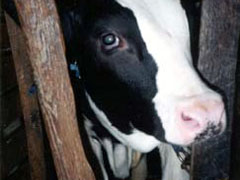Cows
Cows are gentle giants, large in size but sweet in nature. They are curious,
clever animals who have been known to go to amazing lengths to escape from slaughterhouses.
These very social animals prefer to spend their time together, and they form complex
relationships, very much like dogs form packs. Learn more about the intelligence of cattle.
Like all animals, cows form strong maternal
bonds with their children, and on dairy farms and cattle ranches, mother cows can be heard
crying out for their calves for days after they are separated.
In the U.S., more than 41 million of these sensitive animals suffer and die for the
meat and dairy industries every year.1 When they are still very young, cows are
burned with hot irons (branding), their testicles are ripped out of their scrotums
(castration), and their horns are cut or burned off—all without painkillers. Once they
have grown big enough, they are sent to massive, muddy feedlots to be fattened for slaughter
or to dairy farms, where they will be repeatedly impregnated and separated from their calves
until their bodies give out and they are sent to die.
 |
Calves raised for veal are kept in stalls so small that they can’t even turn around. |
Cattle raised for beef are usually born in one state, fattened in another, and slaughtered
in yet another. They are transported hundreds of miles in all weather extremes to the
slaughterhouse. Many cows die on the way to slaughter, and those who survive are shot in the
head with a bolt gun, hung up by their legs, and taken onto the killing floor, where their
throats are cut and they are skinned. Some cows remain fully conscious throughout the entire
process—according to one slaughterhouse worker, in an interview with the Washington
Post, “they die piece by piece.”
Learn more.
1 Animal Place, “Cattle: Not So Free on the Range,”
Animal Place Online, 2005.














 Meet Your Meat: Cows
Meet Your Meat: Cows Cruelty in an Iowa Slaughterhouse
Cruelty in an Iowa Slaughterhouse  Top 10 Reasons Not to Eat Cows
Top 10 Reasons Not to Eat Cows Story of a Downed Cow
Story of a Downed Cow Egregious Cruelty in an Iowa Slaughterhouse
Egregious Cruelty in an Iowa Slaughterhouse